How Long Does Tomato Paste Last in the Fridge
Once opened, tomato paste will last 5-7 days in your refrigerator when properly stored in an airtight container. You'll need to transfer the paste from its original can into a glass or food-grade plastic container immediately after opening, as metal cans can affect the taste and safety. Keep the container in the main compartment of your fridge at 40°F (4°C) or below, not in the door where temperatures fluctuate. Watch for signs of spoilage like mold, unusual discoloration, off-putting odors, or texture changes. If you need longer storage, you can freeze portions in ice cube trays for up to six months. The following storage techniques can help you maximize your tomato paste's shelf life and prevent waste.
This post may contain affiliate links. If you make a purchase through these links, I may earn a commission at no additional cost to you. Additionally, portions of this post may be generated using artificial intelligence (AI) technology. While we strive for accuracy, please be aware that AI-generated content may not always be perfect and should be fact-checked when necessary.
The Spatula Scoops
- Opened tomato paste stored in an airtight container lasts 5-7 days in the refrigerator when kept at 40°F (4°C) or below.
- Transfer leftover paste from cans to glass or plastic containers immediately after opening to maintain freshness and safety.
- Check for signs of spoilage like mold, unusual discoloration, off-putting odors, or changes in texture before using stored paste.
- Store tomato paste in the main refrigerator compartment rather than the door to maintain consistent temperature.
- Freeze unused portions in ice cube trays for extended storage up to six months without quality loss.
Understanding Tomato Paste Storage
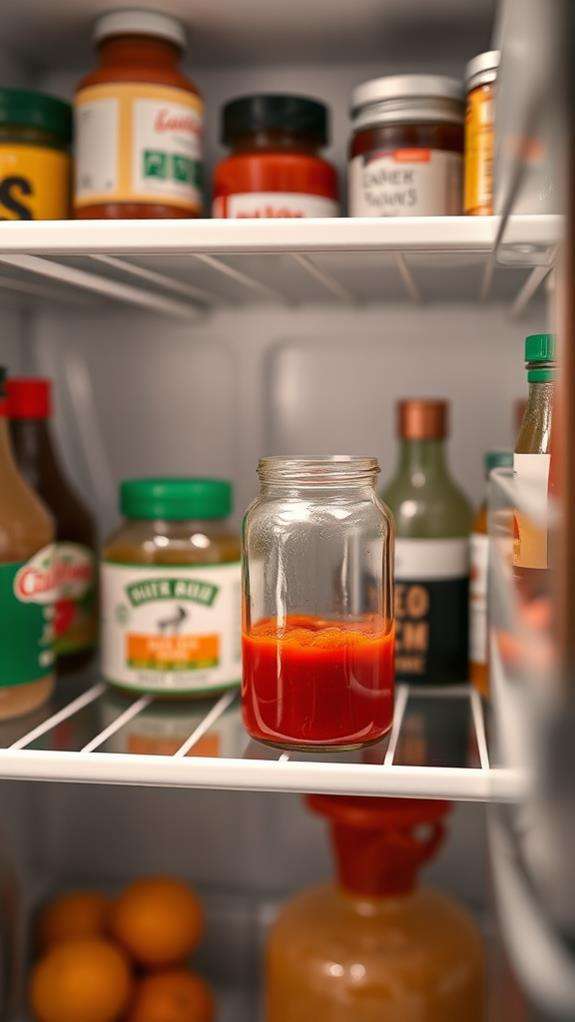
Starting with the basics, tomato paste storage requires specific attention due to its concentrated nature and high acidity levels. You'll need to understand that proper storage methods can greatly extend the product's shelf life and maintain its rich flavor profile.
When you're dealing with tomato paste, you'll find it comes in various packaging options, including cans, tubes, and glass jars. Each container type affects how you'll need to store the product after opening. For canned tomato paste, you shouldn't store the leftovers in the original container, as the metal can react with the acidic tomatoes. Instead, you'll want to transfer it to an airtight glass or plastic container.
Temperature control plays an essential role in preservation, and you'll need to maintain a consistent refrigeration temperature between 35-40°F (1.7-4.4°C). If you're storing unopened tomato paste, you can keep it in your pantry at room temperature, but make sure it's in a cool, dry place away from direct sunlight. The storage area's humidity levels should remain below 60% to prevent premature spoilage and maintain the paste's concentrated consistency.
Signs of Spoiled Tomato Paste
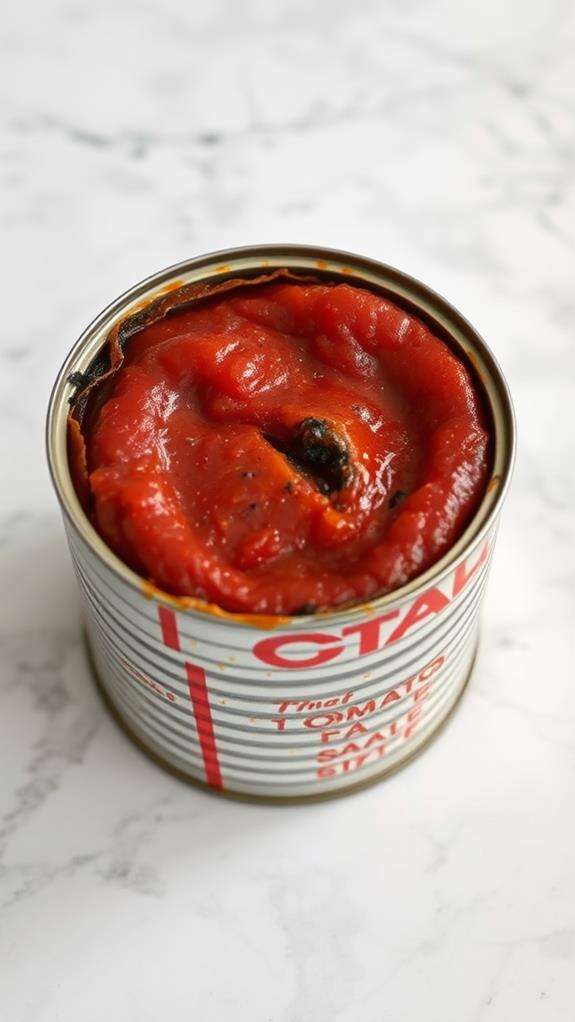
You'll want to watch for several key warning signs that tell you when your tomato paste has gone bad, including darkening color, unusual discoloration, or the presence of mold spots on the surface. The texture of spoiled tomato paste often changes markedly, becoming unusually watery, separated, or developing a thick, crusty layer on top. When checking for freshness, you should also rely on your sense of smell, as spoiled tomato paste typically gives off sour, fermented, or otherwise off-putting odors that differ from its normal sweet-acidic scent.
Visual Warning Signs
Visual indicators provide the first line of defense in identifying spoiled tomato paste. When you're examining your tomato paste, look for any obvious discoloration, particularly dark brown or black spots that weren't there before. You'll want to check the surface carefully, as mold often appears first as small, fuzzy patches in white, green, or black colors.
The texture of your tomato paste should be smooth and consistent throughout. If you notice any separation that won't remix, or if the paste has become watery or unusually thick, it's likely spoiled. Watch out for changes in the paste's natural deep red color – if it's turning maroon or has developed lighter patches, these are clear warning signs of deterioration.
Check the container's edges and lid area carefully, as these spots often show the first signs of spoilage. You might notice dried-out, crusty portions or color changes where the paste meets the air. If the paste has pulled away from the sides of the container or developed an unusual sheen on its surface, it's best to discard it rather than risk foodborne illness.
Texture and Smell Changes
Texture changes and off-putting odors serve as reliable indicators of spoiled tomato paste. When you're examining your tomato paste, you'll want to check for any separation of liquids and solids, as this often indicates the product has begun to break down. Fresh tomato paste should maintain a thick, smooth, and consistent texture throughout.
You'll notice that spoiled tomato paste often develops a watery layer on top, and the overall consistency might become grainy or lumpy. If you spot any fuzzy growth or notice the paste has become unusually thin or runny, it's time to discard it. When it comes to smell, your nose is one of your best tools for detection. Fresh tomato paste should have a sweet-acidic, concentrated tomato aroma. If you detect any fermented, sour, or musty odors, don't take chances.
The paste shouldn't smell yeasty or have any hints of alcohol, which could indicate fermentation has begun. If there's even a slight chemical or "off" smell that doesn't match the familiar tomato scent you're used to, it's better to err on the side of caution and throw it away.
Proper Refrigeration Methods
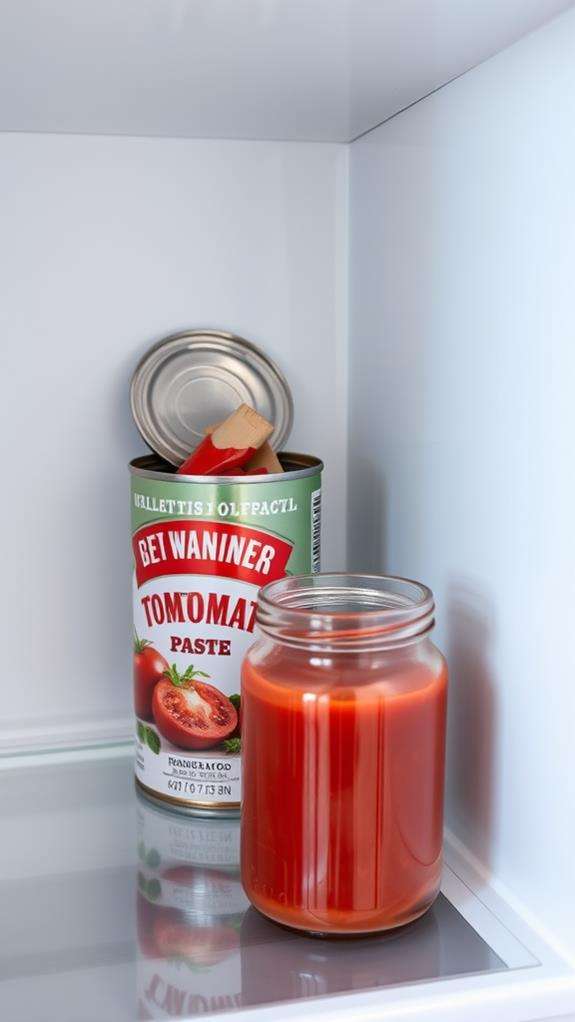
Proper refrigeration safeguards your opened tomato paste from spoilage and extends its shelf life considerably. To maintain peak freshness, you'll need to transfer the leftover paste from its original can into an airtight container, preferably one made of glass or food-grade plastic with a tight-fitting lid.
Store your tomato paste in the main compartment of your refrigerator, where the temperature stays consistently between 35-40°F (1.7-4.4°C). Don't place it in the door compartments, as these areas experience more temperature fluctuations when you open and close the fridge. If you're working with small amounts, you can portion the paste into 1-tablespoon servings using an ice cube tray, cover it tightly with plastic wrap, and freeze the cubes for later use.
For refrigerated storage, you'll want to check that your container is properly sealed after each use. It's also helpful to write the opening date on the container with a permanent marker or masking tape. Keep the paste away from strong-smelling foods, as tomato paste can absorb odors even when properly sealed, and always use clean utensils when scooping out portions.
Storage Container Best Practices

For storing leftover tomato paste, you'll want to transfer it from the original can into either an airtight glass container or a food-grade plastic container, as metal cans can lead to metallic flavors and potential contamination. Glass jars are particularly effective because they don't stain or retain odors, and you can easily see how much paste remains through the transparent sides. To prevent your containers from developing those stubborn orange stains that tomato products often leave behind, consider applying a light coating of cooking oil to the inside of your storage container before adding the paste.
Airtight Containers Vs Cans
When choosing between cans and airtight containers for storing tomato paste, you'll need to contemplate both convenience and shelf life. Unopened cans offer superior longevity, keeping your tomato paste fresh for up to 18 months at room temperature, while properly sealed airtight containers typically maintain freshness for 5-7 days in the refrigerator.
If you're working with leftover paste from an opened can, you'll want to transfer it to an airtight container immediately. Glass or BPA-free plastic containers with secure, tight-fitting lids work best, as they prevent oxidation and contamination. While the original can might seem convenient, it's not ideal for storage once opened, as the metal can interact with the acidic tomato paste, potentially affecting both taste and safety.
When using airtight containers, you'll get better results by choosing ones with minimal headspace above the paste, as this reduces air exposure. Consider using multiple smaller containers rather than one large one, allowing you to open only what you need. This practice helps maintain freshness and prevents waste, especially if you're only using small amounts at a time.
Transfer to Glass Jars
Glass jars stand out as the top choice for storing leftover tomato paste, offering superior protection against flavor changes and contamination. When you're transferring tomato paste from its original container, make sure to select mason jars or glass containers with tight-sealing lids that create an airtight barrier against oxygen and moisture.
Before transferring the paste, you'll need to sterilize your glass jars by boiling them for 10 minutes or running them through a hot dishwasher cycle. Once they're completely dry, spoon the tomato paste into the jars, leaving about 1/2 inch of headspace at the top. You can divide larger amounts into smaller portions using multiple jars, which helps prevent repeated exposure to air when you're only using small amounts.
Don't forget to label your jars with the date of transfer and contents. If you're storing homemade tomato paste, you'll want to write down the ingredients as well. For maximum freshness, press a piece of plastic wrap directly onto the paste's surface before securing the lid, as this creates an additional barrier against oxidation and helps prevent the formation of mold.
Avoid Metal Container Stains
Metal containers and tomato paste can be a recipe for disaster due to the paste's high acidity. When you store tomato paste in metal containers, you're risking both the container's integrity and your paste's quality. The acidic nature of tomatoes will gradually react with the metal, causing discoloration, off-flavors, and potential contamination.
| Container Type | Reaction Risk | Best Practice |
|---|---|---|
| Aluminum | High | Avoid completely |
| Stainless Steel | Medium | Use only briefly |
| Tin-plated | High | Never use |
To protect your tomato paste and containers, you'll want to transfer the paste immediately from metal cans into appropriate storage vessels. If you've noticed black or gray stains on your metal containers, that's a clear sign of chemical reaction. These stains aren't just unsightly – they indicate that metal ions have likely leached into your tomato paste. You can prevent this issue by using glass, ceramic, or food-grade plastic containers with tight-fitting lids. When you're working with tomato paste, always keep a non-metallic spoon or spatula nearby for transferring the product to avoid leaving metal residue.
Extending Shelf Life Tips
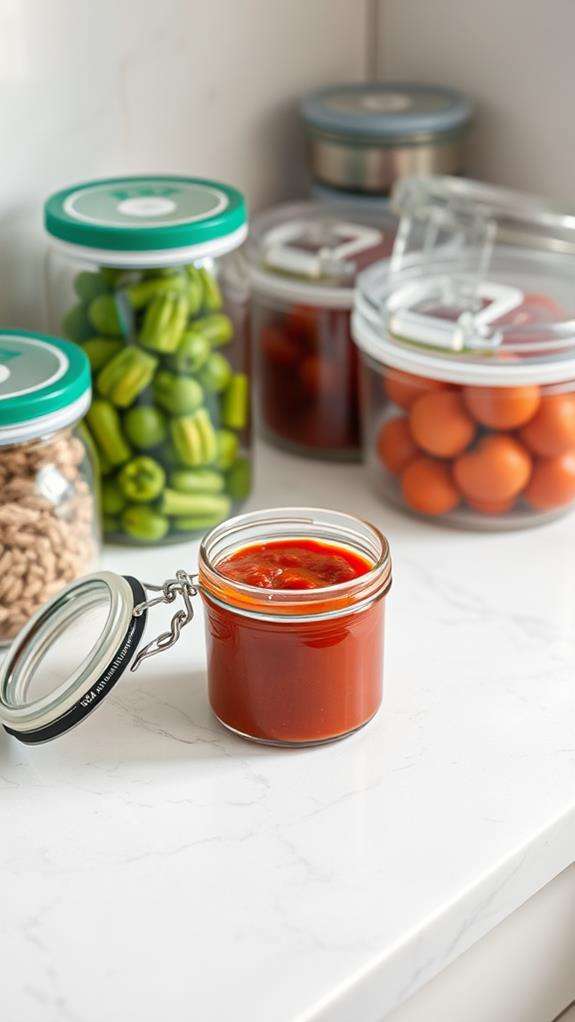
To maximize your tomato paste's longevity, follow several key storage practices. Proper storage techniques can extend your tomato paste's shelf life considerably, helping you avoid waste and save money. You'll want to implement these proven preservation methods as soon as you open a new container.
- Transfer the paste to an airtight container made of glass or food-grade plastic immediately after opening
- Press plastic wrap directly onto the paste's surface before sealing the container to prevent air exposure
- Store the container at the back of your refrigerator where temperatures remain most consistent
- Use clean utensils each time you remove paste from the container to prevent bacterial contamination
- Label the container with the storage date using a waterproof marker or tape
When you're storing larger quantities, consider freezing portions in ice cube trays or tablespoon-sized dollops on a parchment-lined baking sheet. Once frozen, transfer these portions to a freezer bag, removing as much air as possible before sealing. This method allows you to thaw only what you need while keeping the rest preserved for up to six months in the freezer.
Using Leftover Tomato Paste
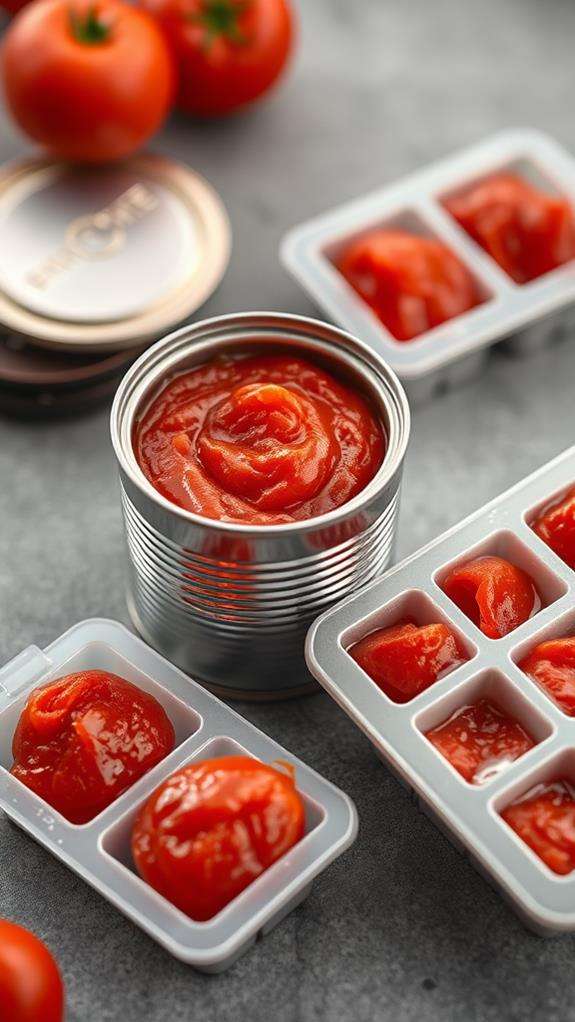
Leftover tomato paste doesn't have to go to waste, even after you've properly stored it. You'll find numerous creative ways to incorporate this concentrated ingredient into your cooking routine, making the most of every last bit.
Add a tablespoon of tomato paste to soups, stews, or chili to deepen their flavor profiles and enhance the overall richness. You can also whisk it into homemade salad dressings, creating a unique tangy element that pairs well with Mediterranean-inspired dishes. For a quick pasta sauce, blend your leftover paste with olive oil, garlic, and herbs. When making rice or grains, stir in a small amount during cooking for a subtle tomato undertone and appealing color.
If you're dealing with smaller amounts, freeze individual portions in ice cube trays (about 1 tablespoon each), then transfer the frozen cubes to a freezer bag. You can also mix leftover paste with softened butter to create a compound butter that's perfect for spreading on bread or melting over grilled meats. Consider stirring it into marinades, pizza sauce, or even scrambled eggs for an unexpected burst of umami flavor.
Freezing Methods for Tomato Paste
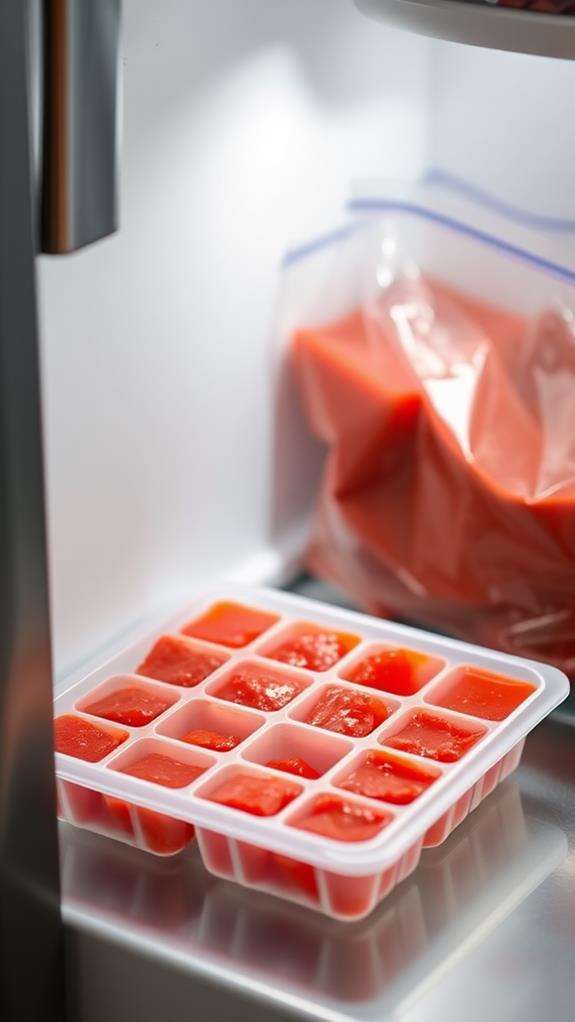
Freezing tomato paste stands out as one of the most practical preservation methods you can use at home. When you're ready to freeze your leftover paste, you'll find several effective techniques that'll help maintain its quality for up to six months.
To get the most from your frozen tomato paste, consider these proven methods:
- Line an ice cube tray with plastic wrap and portion 1-tablespoon amounts, freeze until solid, then transfer to freezer bags
- Drop tablespoon-sized dollops onto a parchment-lined baking sheet, freeze, and store in airtight containers
- Fill snack-sized zip-top bags with 1-2 tablespoons each, flatten, and stack for space-efficient storage
- Use a silicone ice cube tray without plastic wrap (the paste won't stick), then transfer frozen cubes to containers
- Store larger portions in small freezer-safe mason jars, leaving headspace for expansion
Before freezing, you'll want to label each container with the date and amount. When you're ready to use your frozen paste, simply thaw the portion you need in the refrigerator or add it directly to hot dishes. The paste's concentrated flavor and thick consistency will remain largely unchanged after thawing.
Safe Handling Guidelines
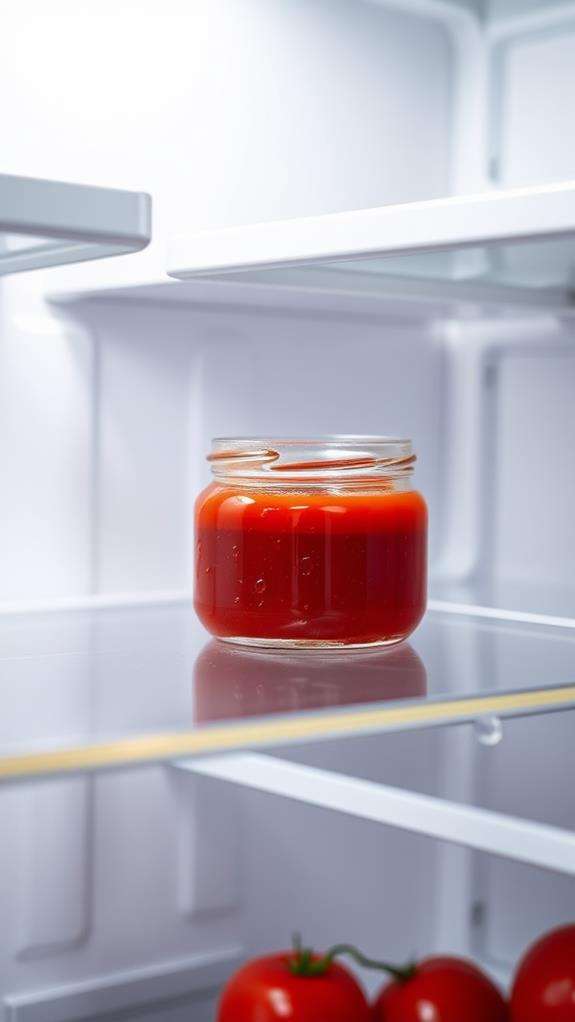
Maintaining proper food safety practices assures your tomato paste remains safe to consume and retains its quality. When handling tomato paste, you'll want to use clean utensils each time you scoop from the container, and avoid double-dipping to prevent bacterial contamination. Always check for signs of spoilage, including mold growth, off-putting odors, or unusual discoloration, before using stored paste.
Store your opened tomato paste in an airtight container at 40°F (4°C) or below in your refrigerator. You shouldn't leave the paste at room temperature for more than two hours, as this creates an ideal environment for bacterial growth. If you're using canned tomato paste, transfer any unused portion to a clean glass or plastic container with a tight-fitting lid.
When handling the container, make sure your hands are clean and dry to prevent introducing moisture or contaminants. If you notice any metallic taste from canned paste, transfer it immediately to a non-reactive container. Don't forget to label your storage container with the date you opened the paste, which helps you track its freshness and assure food safety.
Frequently Asked Questions
Can Tomato Paste Be Used as a Substitute for Fresh Tomatoes?
You can use tomato paste as a substitute for fresh tomatoes, but you'll need to adjust your approach. Since it's concentrated, use 1 tablespoon of paste mixed with 2-3 tablespoons of water to replace one medium tomato. Keep in mind that paste has a more intense, cooked flavor and thicker consistency than fresh tomatoes. It works best in cooked dishes like sauces and stews, rather than in salads or fresh preparations.
Does Tomato Paste Lose Its Nutritional Value When Stored for Long Periods?
Like a battery slowly losing its charge, tomato paste gradually loses some nutritional value during storage, but you'll still retain most benefits. While vitamin C levels may decrease by about 30% after several months, you'll keep most minerals and other nutrients. You won't notice significant losses in the first few weeks when refrigerated properly. The paste's antioxidants, including lycopene, remain relatively stable even during extended storage.
Why Does Tomato Paste Sometimes Turn Darker in Color During Storage?
You'll notice your tomato paste darkening during storage due to oxidation, which occurs when the paste's compounds react with air. This process, similar to how apples brown when cut, happens as oxygen interacts with the paste's natural pigments and enzymes. Temperature fluctuations and exposure to light can accelerate this color change. While this darkening doesn't necessarily mean the paste has spoiled, it's often a sign that it's aging.
Can I Mix Different Brands of Tomato Paste When Storing Leftovers?
Did you know that 94% of home cooks face the dilemma of storing leftover tomato paste? While you can mix different brands of tomato paste for storage, you'll want to take into account a few factors. First, make certain all pastes have similar consistency and acidity levels. You'll get the best results if you combine pastes that share comparable ingredients and manufacturing dates, though it's best to store them separately if possible.
Does Homemade Tomato Paste Have a Different Refrigeration Shelf Life Than Store-Bought?
Yes, your homemade tomato paste typically has a shorter refrigeration life than store-bought versions. While commercial tomato paste can last 5-7 days once opened, homemade paste usually stays fresh for 3-5 days due to the lack of preservatives and commercial sterilization processes. You'll want to store your homemade paste in an airtight container and watch for signs of spoilage like mold, off-odors, or unusual texture changes.





